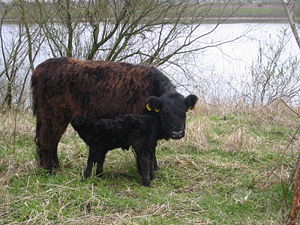
Galloway cattle
Encyclopedia

Beef cattle
Beef cattle are cattle raised for meat production . The meat of cattle is known as beef. When raised in a feedlot cattle are known as feeder cattle. Many such feeder cattle are born in cow-calf operations specifically designed to produce beef calves...
, named after the Galloway
Galloway
Galloway is an area in southwestern Scotland. It usually refers to the former counties of Wigtownshire and Kirkcudbrightshire...
region of Scotland
Scotland
Scotland is a country that is part of the United Kingdom. Occupying the northern third of the island of Great Britain, it shares a border with England to the south and is bounded by the North Sea to the east, the Atlantic Ocean to the north and west, and the North Channel and Irish Sea to the...
, where it originated. It is now found in many parts of the world.
The Galloway was introduced in Canada
Canada
Canada is a North American country consisting of ten provinces and three territories. Located in the northern part of the continent, it extends from the Atlantic Ocean in the east to the Pacific Ocean in the west, and northward into the Arctic Ocean...
in 1853, first registered in 1872, and the first Galloway registry was introduced in the USA in 1882.
The Galloway is naturally hornless
Polled livestock
Polled livestock are livestock without horns, of species that normally have them. The term refers both to breeds or strains which are naturally polled through selective breeding and also to naturally horned animals which have been dehorned...
, and instead of horns has a bone knob at the top of its skull called the poll. This breed's shaggy coat has both a thick, woolly undercoat for warmth and stiffer guard hairs that help shed water, making them well adapted to harsher climates.
The Galloway breed comes from the cattle native to an entire region of Scotland, and originally there was much variation within this breed, including many different colours and patterns. The original Galloway herdbook only registered black cattle, but the recessive gene for red colour persisted in the population, and eventually dun Galloways were also allowed into the herdbook. As a result, although black is still the most common colour for Galloways, they can also be red and several shades of dun.
There are several varieties of the Galloway maintained as consistent strains or breeds.
- The Belted GallowayBelted GallowayThe Belted Galloway is a rare beef breed of cattle originating from Galloway in South West Scotland, adapted to living on the poor upland pastures and windswept moorlands of the region...
features a wide white stripe around its midriff, and is often affectionately referred to as a ‘Beltie’. It was created by crossing Galloways with Belted Dutch cattle, a dairy breed. Belted Galloways are often smaller than Galloways, and often have more of a dairy or aesthetic focus than Galloways.
- The White Galloway is mostly white, with dark points: ears, feet, and around the eyes. They may also have colour on their poll, tail, or udder. The genetics for this colour pattern were introduced from an unknown source, and has happened at least three times - once each in Britain, the USA, and Canada.
- The Riggit Galloway has a colour-sidedColour-sidedColour-sided is a colour pattern of domesticated cattle. It is sometimes called linebackIt consists of a dark body colour, with white finching along the spine, white under the belly, and often white also over the tail, head and legs. The ears, nose and feet are generally dark...
or finch-backed (riggit) pattern, with a white stripe along the line of the back.
In 1906, the American frontiersman Charles "Buffalo" Jones
Charles "Buffalo" Jones
Charles Jesse Jones, known as Buffalo Jones , was an American frontiersman, farmer, rancher, hunter, and conservationist who cofounded Garden City, Kansas...
bred Galloway cattle with bison to produce cattalo but found the mixed breed lacking in fecundity.
Galloways have a thick double-layered coat that is wavy or curly. This thick coat of hair insulates their bodies so well that they have a minimal outer layer of fat on their bodies, which would otherwise create waste at slaughter. This coat sheds out in the summer months and in warmer climates. A 1997 study by the U.S. Belted Galloway Society looked at the weights and sizes of a sample of Belted Galloways in all regions of the United States, finding mature bulls to weigh 1600 pound, mature cows 900 pound, and calf birth weight to be about 72 pounds (32.7 kg).

